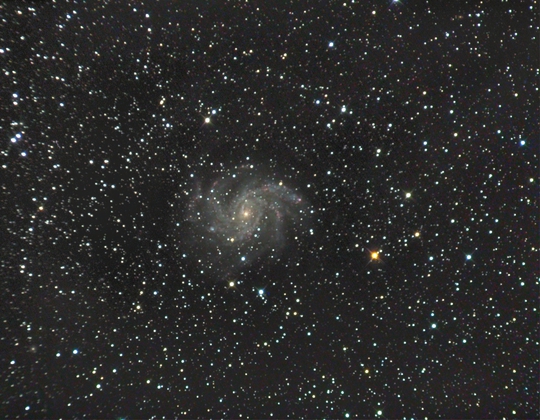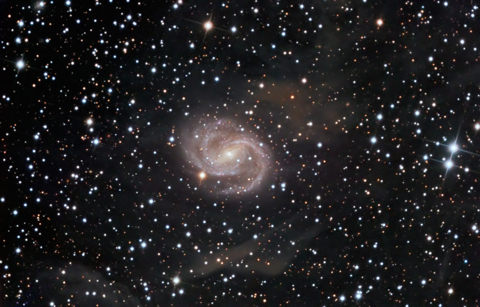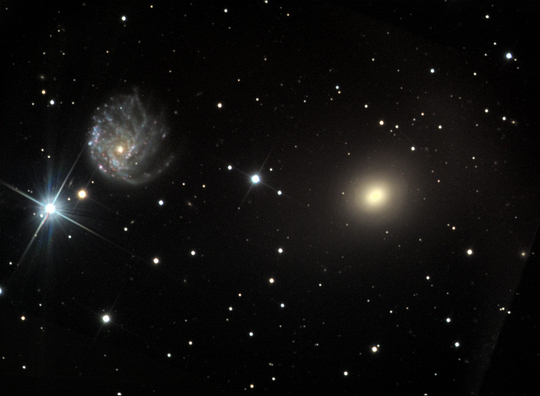Galaxy of the Month in Cepheus
-
October 2014 - Galaxy of the Month
NGC 6951 in Cepheus
This image was provided by Martin Winter and Warren Keller. Please click on it for a high resolution version.
In 1877 Jerome Coggia discovered a nebula in Cepheus that was given the name NGC 6952. Later Lewis Swift independently found a nebula nearby in 1885. Denning later showed that these were one and the same object but Coggia had a positional error of 20’. The designation NGC 6952 was later dropped and Dreyer issued a correction in the IC2.
The galaxy is classified as SAB(rs)bc, a barred spiral galaxy. Its bright core also suggests it is a Seyfert galaxy (a mild active galactic nucleus or AGN). It would appear to be a type two Seyfert galaxy. NGC 6951 lies about 65 million light years away and has been home to two recent supernova in 1999el and 2000E. The galaxies location also means that it is involved with a lot of galactic cirrus as this deep image shows. An even deeper image can be found at the Capella Observatory website. A wide field view of the cirrus can be found on Oleg Bryzgalov's astrophoto website. The galaxy is interesting because it is showing both strong star formation activity and an active core. As the galaxy is an isolated system it is not clear what has triggered the current round of star formation. The galaxy appears to have a circumnuclear ring and the gas flowing through the bar appears to stall here and provide the material for massive star formation. This is not unlike what seems to be happening in our galaxy on a smaller scale. The ring appears to be about 1.5 billion years old and seem to have been forming stars for most of that time.
Visually the galaxy is going to be a difficult target. From typical UK skies I think that at least 30cm+ aperture will be needed. Through a large telescope the galaxy shows a bright core and a fainter envelope. The envelope is definitely elliptical in shape. Smaller instruments may well just show the core.
Owen Brazell - Galaxy Section Director
-
July 2013 - Galaxy of the Month
NGC 2276 and Arp 114 in the Constellation of Cepheus
Image Courtesy of Carlos and Crystal Acosta/Adam Block/NOAO/AURA/NSF. For more images please visit the NOAO website. You can click on image for a high resolution version, or download our Megastar© finder chart of NGC 2276
The galaxy NGC 2276, also known as Arp 25, in Cepheus was discovered in 1876 by Winneke using a 6.5" refractor. It is part of a small group of three to four galaxies that also contains the galaxies NGC 2300 and NGC 2289 and possibly one other.
NGC 2276 is a very oddly shaped spiral galaxy which looks a bit like a tulip. Classified as a Sc I galaxy and it was the asymmetry caused by heavy downstream arc/spiral arm that merited its inclusion in Arp’s atlas of peculiar galaxies. There are some thoughts that the galaxy may be in the process of evolving into a galaxy with a central bar.
The NGC 2300 galaxy group was one of the first imaged in X-Rays and it showed that the X-Ray emitting gas was not associated with either of the main galaxies, NGC 2300 and NGC 2276, but clumped around something else and this was taken as proof of dark matter being heavily associated with small groups of galaxies. The cloud of hot gas was of the order of 1.3 million light years in diameter and with a temperature of the order of a million degrees to glow in X-ray light.
The shaping of NGC 2276 has also been a source of much interest. Originally it was thought to have been ram pressure as it moved through the intra-cluster gas that was causing the shape but more recent X- Ray observations show no signs of the heated gas that would be caused by these shock fronts so the current feeling is that it must be caused by tidal interactions. It is not clear if this interaction is caused by NGC 2300 or another galaxy.
The NGC 2300 group is interesting because it contains NGC 2300 which is an E0/S0 galaxy – a lenticular as well as the spirals NGC 2276 and NGC 2268. Due to the group's proximity to us the angular extent of the group on the sky is large with 1.4 degrees separating the main pair and NGC 2268. The distance to the group is thought to be of the order of 34 Mpc or about 113 million light years.
There have been several supernovae observed in NGC 2276 in the last hundred years, mostly found in the areas of strong star formation. NOAO provide a detailed view of the galaxy.
Although NGC 2276 has its own Arp number as mentioned previously the grouping with NGC 2300 also has the Arp number of 114. In some ways it is difficult to understand elliptical/spiral galaxy pairs as one assumes both galaxies were formed in the same environment and you would assume therefore that they would be of the same type.
Observationally these galaxies may be tricky to find. NGC 2300 is the brighter of the pair and the bright core should show in a 20-22cm telescope. NGC 2276 is fainter and larger and although it may be seen in 22cm it is going to require much larger telescopes to show any detail of its spiral arms.
Owen Brazell - Galaxy Section Director
-
June 2011 - Galaxy of the Month
NGC 6946

Image Courtesy of Dietmar Hager - Linz, Austria. Click on image for a larger version. For more images from Dietmar please visit his website.
The summer is perhaps not the best known season for galaxies but even in constellations better known for nebulae and clusters there are still some bright examples. NGC 6946 on the Cygnus /Cepheus border, better known as the Firecracker galaxy from the number of supernovae that have appeared in it, is one of these.
First discovered by William Herschel in 1798, NGC 6946 is a face on spiral, not dissimilar to M101, which I think would be better known if it was not suffering 1.6 magnitudes of extinction from within our own galaxy. Once believed to be a member of our local group NGC 6946 is now thought to be at a distance of 6.5 Mpc (20 million light years) and as such outside the gravitational radius of the local group. There does appear however to be quite a spread in the distance measurements with a number of sources suggesting it may be as close as 10 million light years (3 Mpc).
NGC 6946 appears to be undergoing a burst of star formation which is unusual in isolated galaxies because these are often triggered by interactions with other galaxies. As far as we can tell NGC 6946 does not appear to be associated with any other galaxy groups. This burst of star formation is probably also the reason that 6 supernovae have been seen in NGC 6946 over the last 100 years or so. NGC 6543 also contains a nuclear star burst which recent observations suggest may well be associated with the formation of a bar in the core of the galaxy.
The morphological classification of NGC 6946 is SAB (rs)cd, relating to its barred spiral nature The magnitude of the galaxy varies with waveband and a blue magnitude of 9.6 is listed in NED. Various sources however give NGC 6946 a visual magnitude of around 8.9. Despite this bright integrated magnitude NGC 6946 has a very low surface brightness due to its size (11.6’ x 9.8’) and it will be likely that a 22cm scope will be required to show any details of the spiral arms at all. Smaller aperture telescopes will show a faint haze and the core. Indeed it does look like a faint globular cluster. Larger instruments should be able to pick out the spiral arms and some of the HII regions that line them. The included finder chart shows some of these regions. A low power field may also show the cluster NGC 6939 to the North west and observers with large telescopes may be able to pick out the edge on galaxy UGC 11583 nearby as well.
Owen Brazell - Galaxy Section Director

